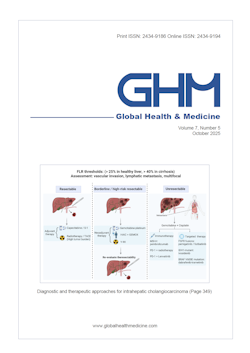Global Health & Medicine 2025;7(3):241-251.
Depressive symptoms and chronic disease trajectories and predictors in middle-aged and older adults in China: An eight-year multi-trajectory analysis
Yan R, Hu Y, Yang J, Wang H, Wang Y, Song G
This study aims to identify and predict latent trajectories of depression and chronic disease among middle-aged and older adults in China using data-driven and interpretable machine learning methods, and to explore key factors that promote healthy aging. To achieve this, we analyzed longitudinal data from 13,073 middle-aged and older adults in the China Health and Retirement Longitudinal Study (CHARLS). Group-based multi-trajectory modeling (GBMTM) was applied to identify latent trajectory groups for depression and chronic disease statuses. Predictive factors included sociodemographic characteristics, health conditions, and lifestyle factors. Machine learning models and dynamic nomograms were used to predict trajectory groups, and model performance was evaluated using the area under the receiver operating characteristic curve (AUROC) and decision curve analysis (DCA). As a result, three main trajectory groups were identified: a normal healthy trajectory group (26.9%), a potential depression and disease increase trajectory group (55.6%), and a high depression and disease burden trajectory group (17.5%). Additionally, the study found that older age, disability, shorter sleep duration, and poor self-reported health status were associated with a higher likelihood of belonging to the latent depression and disease increase trajectory group or the high disease burden trajectory group, particularly among urban women. In conclusion, this study demonstrates that the GBMTM and machine learning models can effectively identify and predict depression and chronic disease trajectories. The identified predictors are crucial for developing targeted interventions to promote healthy aging among the middle-aged and older adults.
DOI: 10.35772/ghm.2025.01061







